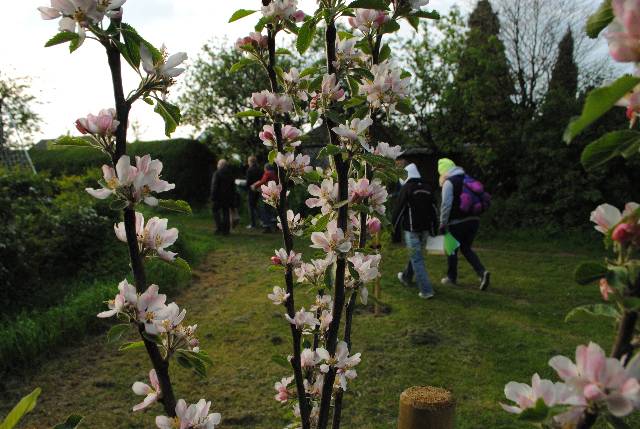‘Taken hostage by nature – choreographed by birds – exhilaration!’ – participant
Barefoot Blindfold took place on Friday the 18th May at 5am, 2012. This was an event to experience the Fruit Route in the early morning followed by shared breakfast. Devised by Anne-Marie Culhane and Paul Coneally the event involved the tasks of listening, silence and sharing reflections. Here are some words I wrote at the time:
“Friday morning I was on campus at 5am. Ten others came along – students, staff and local residents. A chance to experience the campus at daybreak, we located ourselves at the first orchard cluster on the Fruit Route and each of us chose one of the new trees and sat or stood next to it for half an hour wearing blindfolds to enhance our listening. We then took thirty minutes to record or respond to what we had witnessed using words, images, objects. This hour was spent together in silence. After we had breakfast and shared our experiences.This was followed by a breakfast of home made bread, local jams and juice and warm drinks back at the LAGS (Landscaping and Gardening Society) Shed. Ed Darby, ecologist gave us further insight into the sounds of the morning.
This early morning gathering gave me the chance to anchor myself in the Fruit Route as it is now and to think about it emerging into/merging with the university landscape. Time to imagine how the small trees we sat amongst will continue to both shape the place and influence the biodiversity of the campus providing niches and food sources for insects, plants and mammals. To experience the fruit route in the process of becoming alongside others. A local bird is already using one of the tree stakes as a perch.”
I am grateful to Martha Worsching, Lecturer in Department of Politics, History and International Relations for the following reflection.
A very early morning walk in mid-May? It seemed to be a nice idea to get up before five for a change to see the sun rise along the Fruit Route. I had walked along the Route at a more normal hour with a group of people interested in learning more about edible plants growing between the private gardens bordering the campus and the sports fields and halls of residence, and to see the way that nature is keeping and expanding its spaces between the cut lawns was exciting.
Now at the end of the night, on my way to the university the roads were deserted, but on campus many lights were still on and a number of clunking service lorries broke the silence. On this grey and damp morning it took me some time to find the group of Fruit Routers assembling to celebrate the planting and growing of fruit trees and bushes for public consumption.
Among apple and pear trees planted in February and watered in well by a very wet spring, we each chose a tree and sat down in the wet grass, equipped with a small mat to keep the worst damp at bay. A noisy group of students coming home late from partying approached and fell silent when they walked past us, respecting our strange behaviour, sitting in the cold morning dew with black blind-folds.
The cold crept into my bones; despite layers of clothes and attempts to think myself as part of breathing landscape, I felt frozen. The hum of traffic from town seemed to increase. The regular call of a woodpecker, the sound of blackbirds and finches …
When we took our blindfolds off, the sun had risen but was partly hidden in clouds. A faint hint of spring …
Before returning to the Shed for breakfast together, we had time to express our experiences through painting and drawing, arranging objects of nature … The hedges are a tangle of plants, some escaped from the gardens, most of them considered ‘weeds’: goose grass and garlic mustard, dandelions and nettles, elder and whitethorn. Naming them seemed to be a process of acquisition. Later in the year there would be hips and haws and sloes, and of course apples, pears, cherries, even quinces and figs one day, for all to consume. Eat your campus …
